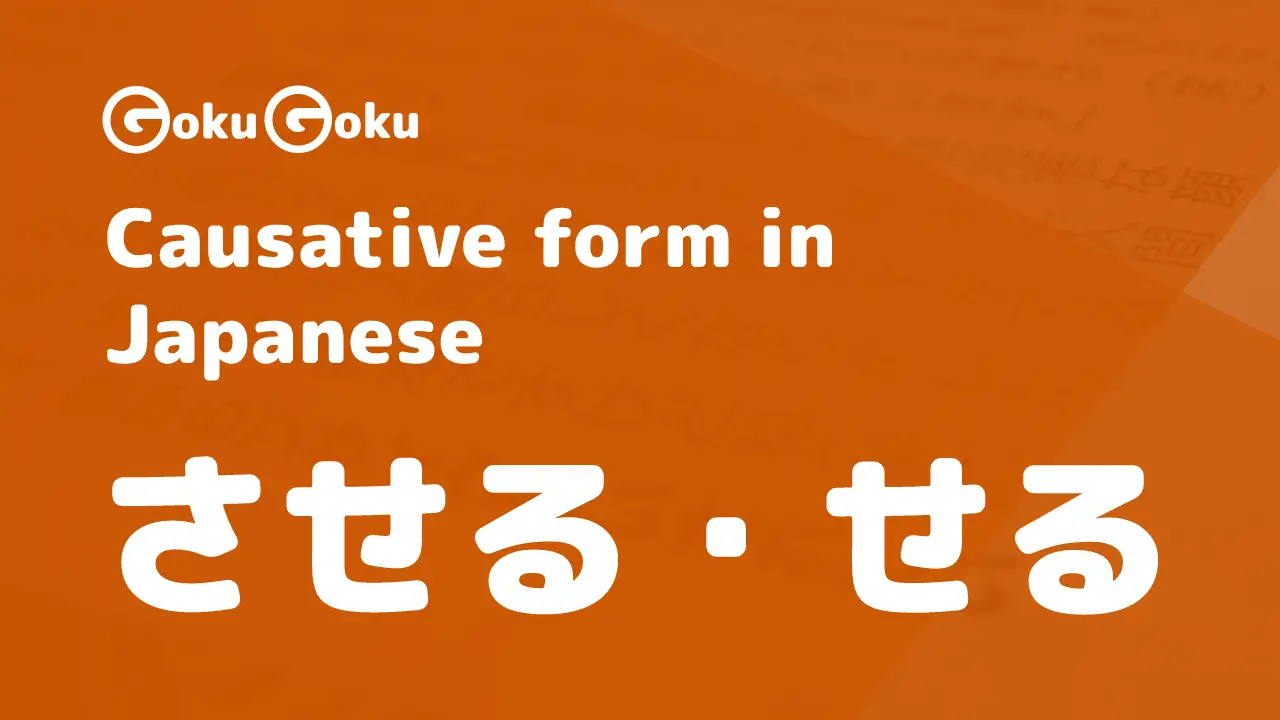Everything You Need to Know About the て Form in Japanese
Sandro Maglione
Get in touch with meThe Te Form (て, te) is a type of conjugation of verbs in Japanese used to express many different meanings.
In this article we are going to see:
How the te form (て) works
How it conjugates
In what contexts it is used
After reading this article you will have a clear idea of how the te form works and how you can it in different situations.
Conjugation of the te form
The te form (て) can be applied to both verbs and adjectives. Their conjugation in the te form varies according to the type of verb (Copula, Ichidan or Godan) or adjective (Adjective in い or Adjective in な).
Te form for the Copula だ
The te (て) form of the copula だ is で (de). It is therefore sufficient to replace だ with で to conjugate the copula into the Te form.
Te form for Ichidan Verbs
For Ichidan verbs the rule is simply to remove the last syllable ~る and replace it with ~て.
Remember: Each Ichidan verb always ends in る in its basic form
Let's see some examples of how to conjugate the te form for Ichidan verbs:
Te form for Godan Verbs
For Godan verbs, the conjugation of the te form (て) varies according to the last syllable of the verb under consideration.
We can divide these conjugations into 4 groups.
Godan verbs ending in ~る, ~う, ~つ
When the verb Godan ends with the syllable ~る, ~う or ~つ, remove the last syllable and add ~って:
Godan verbs ending in ~く, ~ぐ
When the verb Godan ends with the syllable ~く or ~ぐ remove the last syllable and add ~いて and ~いで respectively:
Godan verbs ending in ~ぬ, ~ぶ, ~む
When the verb Godan ends with the syllable ~ぬ, ~ぶ, or ~む, remove the last syllable and add ~んで:
Godan verbs ending in ~す
When the verb Godan ends with the syllable ~す, remove the last syllable and add ~して:
Conjugation of the Te form - Exceptions
For some verbs there are exceptions in their conjugation. These particular verbs are 5 in total:
行く (
go): って instead of いて問う (
ask): うて instead of って請う (
request): うて instead of ってする (
do)くる (
to come), or in kanji 来る
In addition to these 5 exceptions, all other verbs are regular and follow the rules explained above
Te form for adjectives in い
To use the te form (て) for adjectives in い you must:
Remove the suffix ~い
Add ~く (く form of adjectives)
Add the suffix ~て
Let's see an example of how the Te form is conjugated for the adjective 新しい (new):
The only exception here is 良い (good), where the initial い becomes よ (yo):
Te form for Adjectives in な
To conjugate an adjective in な in the te form (て) we must consider its noun form, that is, with the addition of the copula だ.
In this case just change the copula だ to its te form (て), which is で (as seen earlier in this post):
Uses of the Te form
The te form is one of the most used conjugations in the Japanese language.
This form takes on different meanings depending on the type of term or grammatical expression to which it is connected.
To give an idea of the variety of uses of the Te form, let's look at some widely used expressions that contain this form.
Basic て form
In its basic form, when the て is not linked to other terms, the use of the te form is translated as and after.
In this case, in fact, the Te form serves to connect two propositions to each other
In this context the て is used to form a more complex and complete sentence starting from two basic propositions. Let's see an example:
この日本語の文章は複雑で、よく分からなかった。
This concept of Japanese grammar is complicated and I did not understand it well.
The use of the te form (て) for the adjective 複雑 (complicated) (which becomes 複雑で in its Te form) serves to link together two basic clauses which are:
この日本語の文章は複雑だ。
This concept of Japanese grammar is complicated.
よく分からなかった。
I did not understand it well.
As you can see, the addition of the te form (て) connects the two sentences with the conjunction and (which can also be translated as and for this reason, which becomes and for this reason I did not understand it well).
ている
The form ている is used when an action is in progress at the moment. ている is made up of:
Te form (て) of the verb
いる, verb which means
to exist
The literal translation implies that the indicated action is in a "state of existing", which means that the action is in progress.
今ラーメンを食べている。
I am eating ramen now.
As you can see from the example, いる added to the in te (て) form of the verb 食べる (食べて, to eat) indicates that the action of eating is in progress (I'm eating).
Since the literal meaning of ている is "to continue existing in a state" it is also possible to use ている with verbs like 死ぬ (to die) and 知る (to know):
お前はもう死んでいる。
You are already dead.
ている for habits
ている is also used to indicate a habitual actions, such as an hobby or job:
彼は学校で働いている。
He works at school.
In this example we use the form ている to indicate that the action of working is habitual.
ていた
ていた is the past tense form of ている. It therefore indicates an action that was in progress in the past (I was doing).
ていた, similar to ている, is formed by using the te form (て) of the verb combined with いる (to exist) in the past tense, which becomes いた.
窓が割れていた。
The window was broken.
てから
てから is used to indicate that something begins in sequence with another action. てから can be translated as when (A) happens, then (B) or after doing (A), (B).
洗濯をしてから、出かける。
After doing the laundry, I will go out.
てから is added after a verb and simply consists of conjugating that verb in the te form (て) and adding から.
The difference with the て-only form is that adding ~から emphasizes the sequence of actions, particularly how the first action allows you to do the second.
てもいい
てもいい is a expression indicating that something is "okay" as it is. てもいい can also be used to ask if you can or could do something.
お茶冷たくてもいい?
Is it okay even if the tea is cold?
てもいい is added after adjectives (い and な) and nouns. This form consists of:
Te form (て) of the adjective / noun
Addition of も
Addition of いい, which means
goodin Japanese
電車でもいい。
By train is good as well.
Note that the て actually becomes で when added to an adjective in な (which comes from the conjugation of the in te (て) form of the copula, as we saw above)
てください
てください is a polite expression to ask or tell someone to please do something.
手を洗ってください。
Please wash your hands.
てください is added after a verb and its conjugation simply consists of the te (て) form of the verb with the addition of ください (下さい).
In a conversation between friends or family the form ください can also be omitted, leaving only the te form (て)
Where does the expression ください come from
The expression ください actually comes from the verb くださる (下さる) which means to give or to bestow.
In turn くださる is a polite form for the verb くれる (to give).
ていく
This expression is composed of the te form (て) with the addition of the verb 行く, which means to go.
The form ていく has means do and then go:
大きい音で、鳥とりが飛んでいく。
With a loud sound, the bird is flown away.
As you can see from the example, we don't have a literal translation of the meaning of ていく. This expression serves more to emphasize that the subject "is gone" after performing the action.
A more literal translation in this case may be the bird flew and went away.
てくる
The expression てくる is also formed from the te form (て), this time followed by the verb 来る, which means to come.
The form てくる has the nuance of meaning that means to do and then to come.
すぐ帰ってきて。
Come back home soon.
As we see from the example, using てくる adds the meaning of going out of the house and then coming back. In fact, the verb 帰る by itself means to come back, but adding てくる emphasizes how the subject "goes out and then comes back".
These are just some of the forms in which the te form (て) is used. As you can see, the te form is used a lot in Japanese in various contexts and situations.
Some of its meanings cannot even be literally translated. Because of this, the te form tends to be vague and difficult to understand at first.
This article has given you an introduction to the Te form, how it conjugates, and how it is used. In future posts, we will go into even more detail in explaining the various nuances of this form.
Stay up to date with the Grammar section of the website, where we will publish more detailed explanations about the Te form.
If you're interested in staying up to date, sign up for the GokuGoku newsletter below 👇
Thanks for reading.







